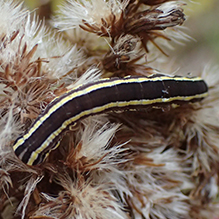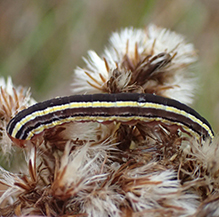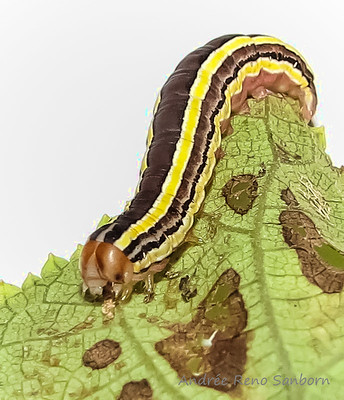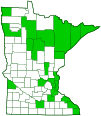striped garden caterpillar moth
(Trichordestra legitima)
Conservation • Description • Habitat • Ecology • Distribution • Taxonomy
|
||||||||
| Hodges # | 10304 |
|||||||
Conservation Status |
||||||||
| IUCN Red List | not listed |
|||||||
| NatureServe | N5 - Secure SNR - Unranked |
|||||||
| Minnesota | not listed |
|||||||
Description |
||
Striped garden caterpillar moth is a common, medium-sized, middle season, arches moth. It occurs in the United States and southern Canada east of the Great Plains. There is also a widely separated (disjunct) population in Colorado and northern New Mexico. It is common in Minnesota. The larvae feed on a wide variety of mostly low-growing plants, including asparagus, aster, beans, bentgrass, black cherry, blackberry, butter and eggs, clover, common yarrow, crabgrass, cudweed, dogbane, goldenrod, milkweed, muhly, mustard, peas, violet, and willow. They are occasionally a pest of garden vegetables, grasses, and agricultural crops, but they rarely occur in numbers large enough to cause economic injury. Mature caterpillars are seen in late summer and fall. Adults are active from June through September in other areas, but in Minnesota their active period is July and August. They are found in open areas, including meadows, woodland openings and edges, and gardens. Adults are ¾″ (20 mm) in length and have a 1″ to 1 9⁄16″ (25 to 39 mm) wingspan. The sensory mouthparts (palps) are moderately long. The antennae on both sexes are slender and simple, not plumose. The thorax has two distinct tufts of hair, one in the front, one at the rear. The forewing ground color is bluish gray. The antemedial (AM) line is represented by two closely spaced lines (doubled). It is slightly scalloped, and it curves upward approaching the leading edge (costal margin). The lower line is dark and distinct, the upper line is lighter and diffuse. The postmedial (PM) line is doubled and deeply wavy. The upper line is dark and distinct, the lower line is lighter and diffuse. The subterminal (ST) line is reddish brown and wavy, with a small black or dark brown spot between the veins. There are three conspicuous spots in the median area, all of them bordered with a dark reddish-brown or black outline. The orbicular spot in the upper median area near the costal margin is large, oval, and pale gray. The claviform spot between the orbicular spot and the inner margin is small and wedge shaped. It is bordered with a black line and is filled with black or dark brown. The reniform spot in the lower median area is large and kidney shaped. It has a black outer outline and a pale inner outline. It is filled with tawny brown and there is a large black smudge on the inner third. There is reddish-brown shading on the wing along the costal margin, in the basal area, and in the outer median area around the reniform spot. The hindwings are yellowish or light brown with dark shading in the subterminal area. The caterpillar is up to 1⅜″ (3.5 cm) in length. It is mostly dark brown above. The first and second segments of the thorax are black, and there is a pale, very narrowly V-shaped mark crossing the two segments. The subdorsal and subspiracular stripes are bright yellow, are bordered above and below with a white line, and are preceded by a black line. The breathing pores (spiracles) are white. The head is orangish brown. There is often a darker brown area over each lobe reaching down to the eyes. |
||
Size |
||
Total length: ¾″ (20 mm) Wingspan: 1″ to 1 9⁄16″ (25 to 39 mm) |
||
Similar Species |
||
Habitat |
||
Open areas, including meadows, woodland openings and edges, and gardens |
||
Ecology |
||
Season |
||
One generation per year: July and August |
||
Behavior |
||
Adults are active at night and will come to lights, but they are also active and will take nectar on cloudy days. They rest with their wings forming a shallow tent over the body. |
||
Life Cycle |
||
|
||
Larva Food |
||
A wide variety of mostly low-growing plants, including asparagus, aster, beans, bentgrass, black cherry, blackberry, butter and eggs, clover, common yarrow, crabgrass, cudweed, dogbane, goldenrod, milkweed, muhly, mustard, peas, violet, and willow |
||
Adult Food |
||
|
||
Distribution |
||||
|
Sources |
|||
| 12/26/2023 | ||||
Occurrence |
||||
Common |
||||
Taxonomy |
|||
Order |
Lepidoptera (Butterflies and Moths) | ||
Superfamily |
Noctuoidea (owlet moths and allies) | ||
Family |
Noctuidae (cutworm moths and allies) | ||
Subfamily |
Noctuinae (cutworms and dart moths) | ||
Tribe |
Hadenini | ||
Genus |
Trichordestra | ||
This species was formerly placed in the genus Lacanobia. |
|||
Synonyms |
|||
Apamea legitima Lacanobia legitima Mamestra legitima Polia legitima |
|||
Common Names |
|||
striped garden caterpillar (larva) striped garden caterpillar moth (adult) |
|||
Glossary
Claviform spot
A club-shaped, wedge-shaped, or round spot in the upper median area, between the orbicular spot and the inner margin, connected to the AM line, on the forewing of many moths.
Costal margin
The leading edge of the forewing of insects.
Orbicular spot
A circular spot or outline in the upper median area near the antemedial line on the forewing of many moths.
Palp
Short for pedipalp. A segmented, finger-like process of an arthropod; one is attached to each maxilla and two are attached to the labium. They function as sense organs in spiders and insects, and as weapons in scorpions. Plural: palpi or palps.
Reniform spot
A kidney-shaped spot or outline in the lower median area near the PM line on the forewing of many moths.
Spiracle
A small opening on the surface of an insect or arachnid through which it breathes.
Visitor Photos |
|||||
Share your photo of this insect. |
|||||
| This button not working for you? Simply email us at info@MinnesotaSeasons.com. Attach one or more photos and, if you like, a caption. |
|||||
Babette Kis |
|||||
Trichordestra legitima (striped garden caterpillar moth) Trichordestra legitima, striped garden caterpillar moth, photographed on Oct. 18, 2023 at Barnes Prairie, Racine Co., WI. The caterpillar is on a goldenrod seed head. |
 |
||||
 |
|||||
MinnesotaSeasons.com Photos |
|||||
|
|||||

Slideshows |
||
| Striped Garden Caterpillar Moth - Hodges#10304 (Trichordestra legitima) Andree Reno Sanborn |
||
 |
||

Visitor Videos |
|||
Share your video of this insect. |
|||
| This button not working for you? Simply email us at info@MinnesotaSeasons.com. Attach a video, a YouTube link, or a cloud storage link. |
|||
Other Videos |
|||
| Trichordestra Legitima? IloveSPIDERZ |
|||
About
Nov 9, 2009 Can anyone tell me the species of this pretty catterpillar? I'm so curious, and I want to know. This video is especially for: |
|||
| Striped Garden Caterpillar - Trichordestra legitima 10-22-09 Marcie Oconnor |
|||
About
Oct 23, 2009 I found this caterpillar on a drying head of Stiff Goldenrod, in a sandy prairie in western Wisconsin. It seems to be eating parts of the goldenrod seeds, although I can't quite tell which parts. It should pupate soon, and spend the winter as a pupa. |
|||


Created: 12/26/2023
Last Updated:

